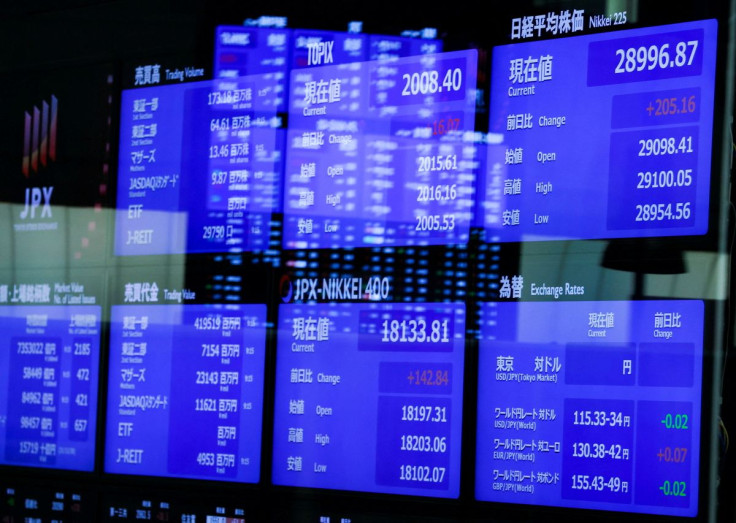Deepening Ukraine Crisis Jolts Stocks, Sends Oil Surging

Global stocks tumbled while safe-havens rallied and oil surged on Tuesday as Europe's eastern flank stood on the brink of war after Russian President Vladimir Putin ordered troops into breakaway regions of eastern Ukraine.
MSCI's broadest index of Asia Pacific shares outside Japan was on course for its worst day for this month, off 1.66%, weighed by markets in Hong Kong and mainland China. Japan's Nikkei shed 1.7%.
U.S. and European markets were also braced for sharp losses at the opening bell, with S&P 500 futures down 1.4%, Nasdaq futures off 1.9%, the pan-region Euro Stoxx 50 futures 1.1% lower, and FTSE futures down 0.6%.
Both Asian shares and U.S. and European futures had fallen more earlier in the session.
In contrast, Brent crude futures rose 2.1% to $97.44, a new seven-year high, on worries Russia's energy exports could be disrupted. Spot gold added 0.1% to $1,908.10, having earlier hit a new six-month top of $1,913.89. [GOL/] [O/R]
Putin on Monday recognised two breakaway regions in eastern Ukraine as independent and ordered the Russian army to launch what Moscow called a peacekeeping operation into the area, upping the ante in a crisis that could unleash a major war.
A Reuters witness saw columns of military vehicles including tanks early Tuesday on the outskirts of Donetsk, the capital of one of two breakaway regions, and Putin signed treaties with leaders of the two breakaway regions giving Russia the right to build military bases.
Washington and European capitals condemned the move, vowing new sanctions. Ukraine's foreign minister said he had been assured of a "resolute and united" response from the European Union.
Following Russia's latest move "we are much closer to military intervention, which of course is going to drive a lot of the risk off sentiment in the markets," said Carlos Casanova, senior Asia economist at UBP, adding the short term volatility in markets caused by both geopolitical factors and the U.S. Federal Reserve was 'relentless'.
Casanova said the consequences would be higher oil prices, an equity sell off, and people flocking to safe haven assets like the Japanese yen.
In Hong Kong, shares of Russian aluminium producer OK Rusal plunged as much as 22.1% to HK$6.18, their biggest daily percentage decline since April 2018.
Away from Russia, and not helping the Hong Kong market, Hong Kong-listed Chinese tech stocks fell 2.3%, with heavyweights Tencent and Alibaba both hit by speculation about a new wave of regulatory scrutiny.
CURRENCIES QUIETER
In currency markets, moves were more muted, barring the Russian rouble which hit an 15-month low early in Asian trading, before steadying.
The Japanese yen walked back early gains which had taken it to a near three-week high of 114.48 per dollar, fellow safe-haven the Swiss franc was holding steady near the previous day's one-month high, and the euro recovered to trade flat after earlier falling to a one-week low of $1.1286.
"Currency markets are not really showing the same level of caution as equity markets," said Matt Simpson, senior market analyst at City Index.
"When you read the headlines .. you'd expect to see some follow-through in the markets. We are in equities but we're not in currencies," he said.
"Interestingly, overnight the Swiss franc was the safe haven, not the Japanese yen."
The nerves also drove U.S. Treasury yields lower, with benchmark 10-year Treasury yields diving as much as 7 basis points to 1.846%. Bets on Federal Reserve rate hikes also eased and the chance of a 50 basis point hike next month fell below 1-in-5.
U.S. policy makers have been sparring publicly about how aggressively to begin tightening.
Federal Reserve Governor Michelle Bowman said on Monday that she will assess incoming economic data over the next three weeks in deciding whether a half percentage point interest rate rise is needed at the central bank's next meeting in March.
© Copyright Thomson Reuters 2024. All rights reserved.




















